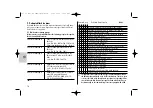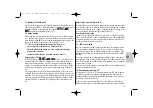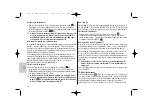
82
ķ
10.3 Close-ups / macro shots
In close-ups and macro shots, parallax error between the flash unit and lens
may result in shadows on the lower edge of the image. To compensate for this,
the main reflector
can be tilted downwards by an angle of -7°. To do this,
depress the reflector unlocking button
and tilt the reflector downward.
Certain minimum lighting distances must be maintained for close-up shots to
avoid over-exposure.
The minimum lighting distance is approximately 10% of the maximum
flash range indicated in the display. When the reflector head is tilted
downwards, the maximum flash range flashes as an indication. For clo-
se-up shots, make sure that the flash light is not shaded by the lens!
10.4 Flash exposure memory
Some Group E cameras (see Table 1) have flash exposure memory (FV memo-
ry). This is supported by the flash unit in i-TTL and i-TTL BL flash mode. It can be
used to define and store the exposure level for the subsequent shot before the
shot is actually taken. This can be useful when, for example, the flash exposure
has to be adjusted to specific details that may not be necessarily be identical
with the main subject.
The function is activated on the camera, in some instances as an individual func-
tion. The subject detail to which the flash exposure is to be adjusted is sighted
and brought into focus with the AF sensor/metering window in the camera.
When the AE-L/AF-L button (the terminology may vary with the camera model)
on the camera is pressed, the flash unit fires a test flash. The stored metering
value, for example „EL“, is then displayed in the camera viewfinder. The camera
uses the reflected light of the test flash to determine the light output required for
the subsequent exposure.
The actual main subject can then be brought into focus with the camera’s AF
sensor/metering window. When the shutter release is pressed, the picture will
be exposed with the previously defined light output of the flash unit!
☞
For more detailed information on adjustments and handling, refer to the
camera’s operating instructions!
11 Flash synchronisation
11.1 Automatic flash sync speed control
Depending on the camera model and camera mode, the shutter speed is swit-
ched to flash sync speed when flash readiness is reached (see the camera’s ope-
rating instructions).
Shutter speeds cannot be set faster than the flash sync speed, or they are swit-
ched automatically to the flash sync speed. Various cameras have a sync speed
range, for example from 1/30 sec to 1/125 sec (see the camera’s operating
instructions). The sync speed set by the camera depends on the camera mode,
the ambient light, and the focal length of the lens used.
Shutter speeds slower than the flash sync speed can be set according to the
camera mode and the selected flash synchronisation (see 11.3 and 11.4).
If a camera with a between-the-lens shutter and high-speed synchronisa-
tion (see 11.5) is used, flash sync speed is not controlled automatically.
As a result, the flash can be used at all shutter speeds. If you need the
full light output of the flash unit, you should not select a shutter speed
that is any faster than 1/125 sec.
11.2 Normal synchronisation
In normal synchronisation the flash unit is triggered at the beginning of the shut-
ter time (first curtain synchronisation). Normal synchronisation is the standard
mode on all cameras. It is suitable for most flash shots. The camera, depending
on the mode being used, is switched to the flash sync speed. Speeds between
1/30 sec. and 1/125 sec. are customary (see the camera’s operating instruc-
tions). No settings are necessary on the flash unit, nor is there any display for
this mode.
☞
☞
707 47 0081.A2 48AF-1Nikon/Inh. 19.09.2007 12:42 Uhr Seite 82
















































